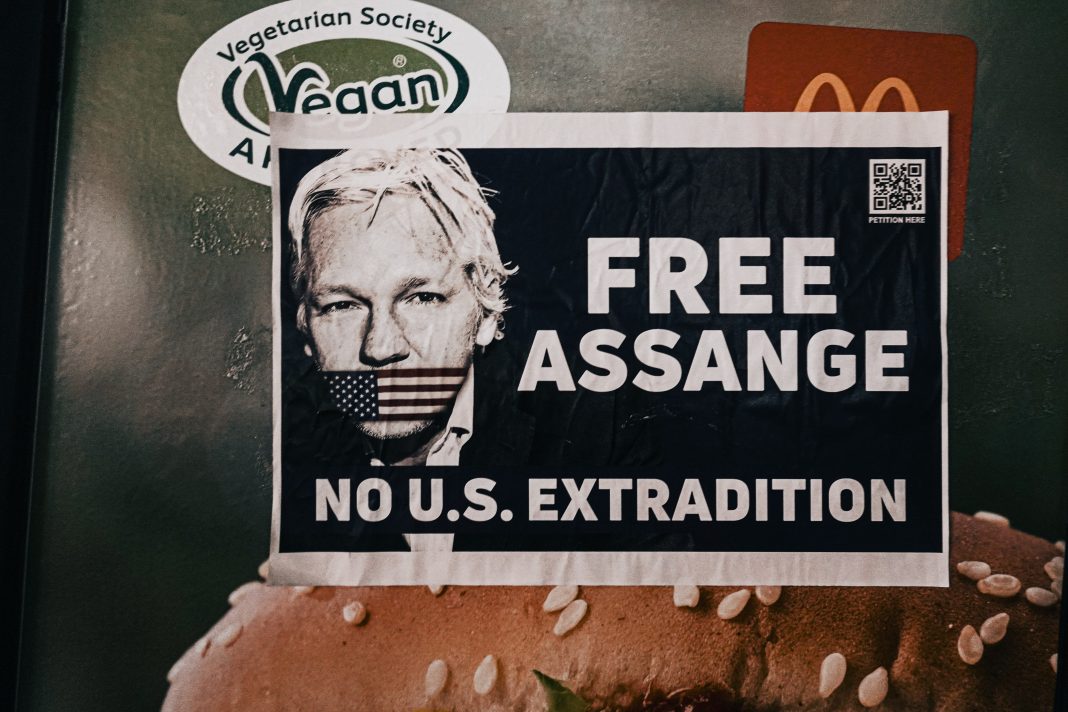By Azeezah Kanji* – Truthout
As the British government moves ever closer to extraditing WikiLeaks founder Julian Assange to the United States, the pantomime of “justice” cloaking his persecution in the regalia of the “rule of law” continues to unfold: a torture rendition by another name, inching forward as the world watches in real time. On June 17, the U.K.’s Home Secretary Priti Patel approved the extradition of Assange to the United States, following the magistrate court’s order that the transfer should proceed.
In this fundamentally skewed process, Assange’s capacity to meaningfully defend himself has been systematically assaulted by government smear campaigns; surveillance of his lawyers; and stultifying, arbitrary rules and restrictions obstructing him from participating in his own case — as documented in detail by United Nations Special Rapporteur on Torture Nils Melzer in his recent book, The Trial of Julian Assange.
Previously, U.S. officials discussed “options” for kidnapping Assange and assassinating him by poison — tactics ultimately dismissed as “something we’d do in Afghanistan,” Egypt or Pakistan, but not the U.K. Therefore, they’ve opted for the more “civilized” alternative. Instead of kidnapping, extradition. And instead of assassination, entombment in the torturous U.S. carceral system, where Assange faces a death-in-prison sentence of 175 years for exposing U.S. war crimes in Afghanistan and Iraq.
How is this, in essence and effect, anything but the “legal” equivalent of an extraordinary rendition — defined by the American Civil Liberties Union as “the practice of capturing people and sending them to countries that use torture or abuse in interrogations”?
While the U.S.’s infamous extraordinary rendition program has (now) been officially condemned and supposedly ceased, rendition to torture via legalized means is enduringly embraced.
In “extraordinary” rendition, hundreds of “war on terror” detainees were secretly imprisoned and brutalized in CIA black sites around the world. In “legalized” rendition, the torture chambers are not foreign black sites but prisons transformed into “Guantánamo Norths” within the U.S. itself.
In “extraordinary” rendition, victims were seized off the streets extrajudicially by the CIA. In the “legalized” version, the condemned are delivered into U.S. hands through judicially sanctioned means such as extradition — abusive processes accorded an aura of legal legitimacy.
U.S. courts have upheld transfers into U.S. custody even when the targets have been abducted at gunpoint, severely beaten, burned, kept in secret offshore captivity for weeks or months (an increasingly popular practice with U.S. law enforcement), and electrocuted in their feet and genitals: acts of violence for which the courts have refused to provide any legal redress because they occurred outside the U.S.
While the U.S.’s infamous extraordinary rendition program has (now) been officially condemned and supposedly ceased, rendition to torture via legalized means is enduringly embraced.
In “legalized” rendition, as in “extraordinary” rendition, detainees have been subjected to intensive solitary confinement, forced nudity, sexual humiliation, sensory deprivation, extreme light and temperature exposure, and other mechanisms of deliberate “psychic demolition”; although the degree of isolation and control achieved in domestic U.S. prisons under regimes such as “special administrative measures” is in many ways even more totalizing than at Guantánamo Bay.
Solitary confinement for more than 15 days constitutes a violation of the UN Convention Against Torture, according to UN experts; yet U.S. “supermax” facilities are specifically designed to incarcerate hundreds of prisoners in crushing isolation for not days, but years, on end.
In extraordinary rendition, the victims were disappeared into “legal black holes.” In legalized rendition, the law itself is wielded as an instrument to dominate and torment.
As Richard Abel, distinguished professor of law at the University of California Los Angeles, observes in his book, Law’s Trials: The Performance of Legal Institutions in the US “War on Terror”: “Conservatives have accused those defending the rule of law of committing ‘lawfare’: abusing law to obstruct the government’s essential and legitimate conduct of the ‘war on terror.’ But ‘lawfare’ better characterizes how the government itself has deployed law in waging that ‘war.’”
Ahmed Abu Ali, for instance, was extradited to the U.S. on “terrorism” accusations, after almost two years of detention in Saudi Arabia without charge. U.S. judges declared that his confession to Saudi interrogators was “voluntary” — “the court found believable the testimony of Saudi officers that they confined Abu Ali under reasonable conditions” — even in the face of the torture scars on his back, and the U.S. State Department’s own previous reports testifying to Saudi authorities’ use of “torture and abuse to obtain confessions from prisoners.”
Despite the court’s acknowledgement that “the independent evidence does not prove Abu Ali’s guilt of any crime,” he was sentenced to 30 years. This was subsequently increased to a life sentence upon appeal. Ali continues to endure this sentence under a shroud of solitary confinement and secrecy so opaque his own family has not been allowed contact visits with him for 17 years.
Incredibly, U.S. courts have even managed to find that confessions were legally valid and uncoerced when procured at known U.S. torture centers like Bagram Air Base — “Afghanistan’s Abu Ghraib,” where detainees were hung from the ceiling, shackled naked in stress positions, and beaten so harshly that autopsies revealed injuries comparable to being run over by a bus.
Aafia Siddiqui’s admission to attempting to shoot a U.S. soldier in Afghanistan was deemed “voluntary” by the U.S. Court of Appeals, on the basis of FBI agents’ assertions that “during the course of her stay at Bagram … the agents endeavored to meet Siddiqui’s needs as best they could.” She is now on year 12 of a 86-year sentence at the federal penitentiary in Fort Worth, Texas, illustrating yet again how in the U.S. criminal legal system, extralegal torture and legal punishment are two sides of the same sword.
Yemeni cleric Mohammed Al-Moayad — known as the “father of the poor” — was lured to Germany by a CIA entrapment operation promising donations to his charities, and then extradited to the U.S. on charges of funding “terrorist” groups.
Al-Moayad’s original sentence of 75 years was eventually overturned because of the gross unfairness of his trial, and he was deported back to Yemen — but not before he was made to survive five years of draconian solitary confinement during the drawn-out “due process” of his trial and appeal.
Whether by imposition of prolonged pretrial isolation, or the threat of extreme sentences if defendants refuse to acquiesce to guilty plea deals and risk going to trial instead, the legal process itself is used to tighten the screws of suffering and force subjects to submit to officials’ will: the definition of torture in international law.
In the U.S. criminal legal system, extralegal torture and legal punishment are two sides of the same sword.
Soccer player Nizar Trabelsi has been incarcerated in unrelenting solitary confinement while awaiting trial for the last nine years, since his extradition from Belgium to the U.S. in 2013. The extradition was carried out despite the European Court of Human Rights finding that it would violate the international legal prohibition against inhuman and degrading treatment.
Under this regime of total isolation, psychologists report that Trabelsi has been hearing voices, hallucinating insects and animals, talking to the light in his cell (which is kept on 24 hours a day), and banging his head against the wall so hard that it bleeds: a condition considered “within normal limits” of mental health, according to the prison’s official medical assessments.
In the case of British “terrorism” extraditee Haroon Aswat, the U.K. went through the ritual of securing U.S. “assurances” that he would receive appropriate medical care for his diagnosis of paranoid schizophrenia, on the strength of which his extradition was approved by the European Court of Human Rights.
In reality, however, Aswat was held under extreme solitary confinement at the notorious Metropolitan Correctional Center in New York — described as even more oppressive than Gitmo by a prisoner who experienced both — and then transferred to a series of prisons across the U.S., where his mental health has so deteriorated that he made three suicide attempts in one year alone.
Perversely, U.S. prison officials cite Aswat’s present state of psychological instability — generated by his imprisonment — as a reason to continue keeping him imprisoned: a vicious carceral circle. He is currently at the Federal Correctional Institution in Sheridan, Oregon, where prisoners have been deprived of their psychiatric medications and other basic necessities like drinking water that is not out of a toilet, maggot-free meal trays, bathrooms, health care and heating — an “excruciating experience,” in the recent words of one judge.
The U.S., too, made a habit of obtaining “assurances” of good treatment, before sending captives off to extraordinary rendition sites abroad. “They say they are not abusing them, and that satisfies the legal requirement, but we all know they do,” as one U.S. official admitted. It seems the “assurances” given by the U.S. have the same value as those solicited by the U.S.: not to protect the incarcerated, but to provide a shield of plausible deniability for those responsible for their unmitigated torment.
While the U.S. industriously extracts “confessions” and dispenses “justice” to others around the world, the blatant evidence of its own misdeeds is perpetually expunged, explained away, exceptionalized, or (self-)excused.
In September, for instance, a U.S. court dismissed a lawsuit by former detainees who were arbitrarily rounded up en masse after 9/11 and isolated in tiny cells, beaten, shackled, stepped on, slammed face-first into pictures of the U.S. flag pinned on the walls, gratuitously strip-searched and videotaped, forcibly sleep deprived, and verbally assaulted with racist slurs, such as “camels,” “terrorists,” and “f***ing Muslims” by guards at a maximum-security prison in New York.
According to the court, permitting prison officials to be sued for such behaviors would not increase accountability, but on the contrary imperil it, because then the officials would simply “choose not to report abusive acts by correctional officers” at all. In other words, when it comes to prison brutality, the available options are secrecy or impunity; justice is completely off the table.
Yet, despite all this, the U.S. prison system continues to be treated as a permissible extradition destination. Greenlighting Assange’s transfer, the British High Court remarkably characterized the U.S.’s loophole-riddled “assurances” regarding the conditions of his imprisonment as “solemn undertakings, offered by one government to another … [which] the USA has in the past frequently provided, and invariably fulfilled.”
In refusing to dislodge their presumption of U.S. benevolence, courts insist that “the graver the allegation [of U.S. violations], the stronger must be the evidence to prove it” — the exact opposite of the logic deployed to sweepingly criminalize alleged “terrorists” and other official enemies of the state.
From extraordinary rendition to mass incarceration, the U.S.’s “empire crimes” have been repeatedly exposed and copiously documented, yet immunized by courts as “state secrets” or “unproved.” This ongoing failure to recognize the “evidence” can only be described as torturously willful ignorance.
……………………………………….
*Azeezah Kanji is a legal scholar and writer based in Toronto, Canada. She is a regular opinion contributor to Canadian and international media on issues relating to racism, law and social justice.
Read more on our partner website:
Cover image: Samuel Regan-Asante
























